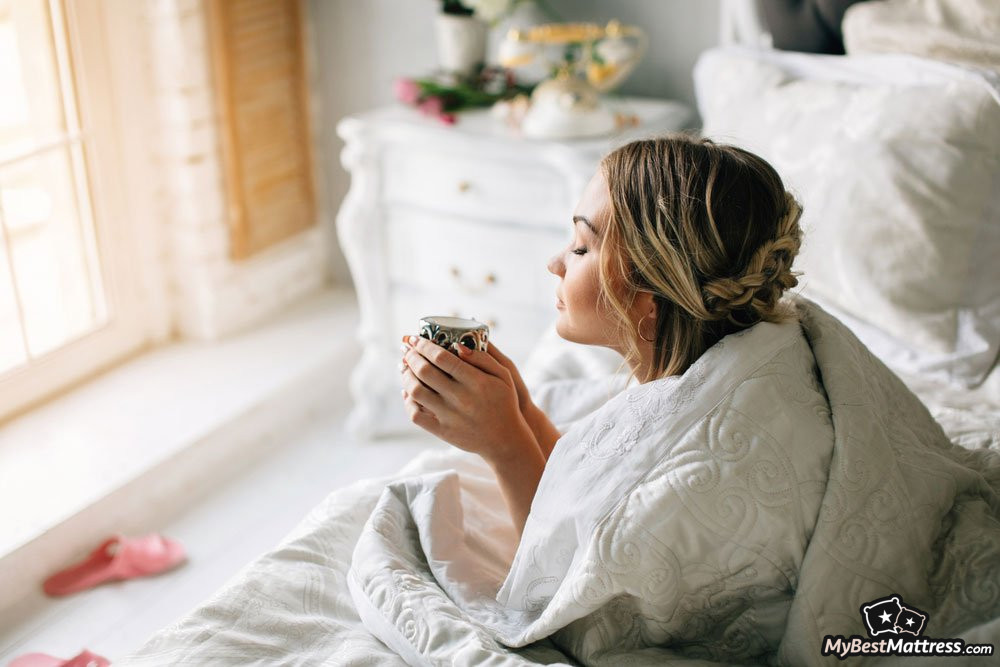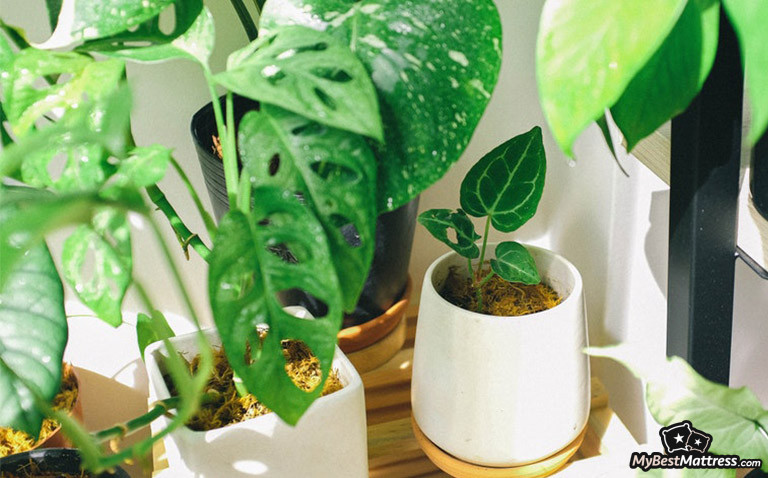
Do you have any plants at home? I don’t mean gifted flowers in a vase, I’m talking about potted plants. Or more specifically, do you have any bedroom plants? There are actually plants that help you sleep, aside from their usual benefits.
You may already be sleeping well enough. You have a high-quality mattress, you practice great sleep hygiene, you have a healthy and stress-free lifestyle. Even if your sleep already feels like the best — plants for bedroom can add wonderful improvements to your sleep quality.
Table of Contents
- 1. Why Should I Get a Plant?
- 2. But Why Do I Need Plants In The Bedroom?
- 3. Smell the Flowers. I Mean, the Plants
- 4. Oxygen from Plants
- 5. Indoor Plants That Produce a Lot of Oxygen
- 6. Indoor Plants That Produce Oxygen at Night
- 7. NASA Clean Air Study
- 8. Air-Purifying Plants
- 9. Alternative Measures to Improve Your Sleep
- 10. Things To Consider When Buying Bedroom Plants
- 11. Conclusions
Why Should I Get a Plant?
You may be wondering if you should get a plant and if they’re useful in the first place. I definitely recommend doing so. There are quite a few benefits to having a plant.
Firstly, plants give you company. They’re like a silent and less needy version of a pet. Surely, they can’t talk to you, but you can definitely talk to them. And they’re still another living and breathing entity in your house.
Plants provide the social aspect without having to attend to them on an extremely frequent basis. You can definitely develop an emotional bond with your plant (I’ve always given first names to mine) and feel like you have a companion.
In addition, it’s a nice decor for your home. Whether you’re matching the color palette, or your shelf is just missing an accessory, the variety of potted plants will have something to suit your needs. Not just that, it will make your room or the whole home look cozier and warmer.
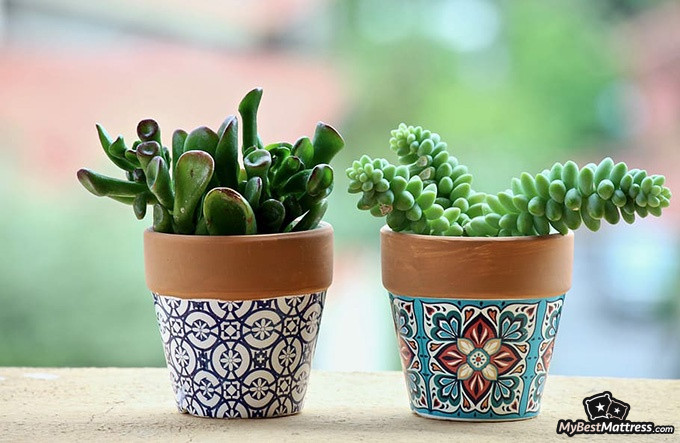
Taking care of a plant adds up to your daily routine. At first, it can sound tedious, but this additional chore can actually get you into the habit of a regular routine. This way it would help you tackle other tasks you have been procrastinating for weeks. With the wide selection of plants, you can build your discipline and routine from the lowest-maintenance ones.
Actively taking care of a plant, or just interacting with it, can decrease the levels of both physical and mental stress[1]. It calms you down and allows you to feel comfortable. It lowers down the sympathetic nervous system, which directly reduces the level of stress you’re feeling.
It improves the air quality. By producing oxygen, it makes the air in the house fresher. There have also been studies done about certain plants' abilities to remove specific toxins from the air.
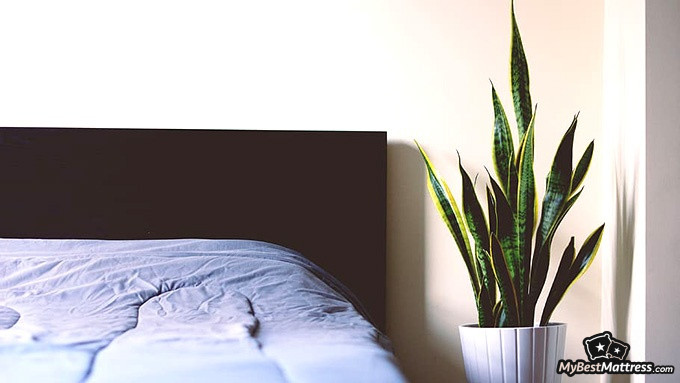
In addition to releasing oxygen, it releases fragrant smells. The benefits of aromatherapy have been studied for certain scents. But no matter the specific fragrances for potential benefits, simply having a nice-smelling plant brightens up the quality of your daily life.
Depending on the plant you acquire, you could also have some very practical use. Herbs like basil, mint, parsley, or thyme can definitely be grown in potted plants. Once they mature, you can quickly nibble a leaf or two off for your cooking projects.
But Why Do I Need Plants In The Bedroom?
Having plants in your home is great. But what about having bedroom plants specifically? Why should you get or bring your plants to this room instead of, for example, leaving them on the windowsill in the kitchen?
Well, like mentioned, plants have numerous benefits. And some of those benefits are especially relevant for your sleep, and thus, bedroom. Of course, they are not as strong as, for example, sleeping on a superb mattress, but they're still quite valuable.
Firstly, plants can calm you down. Aside from reducing stress or anxiety, they also simply help you to be more mellow and ease you into internal sleeping mode. And plants that make you calmer, essentially are plants that help you sleep.
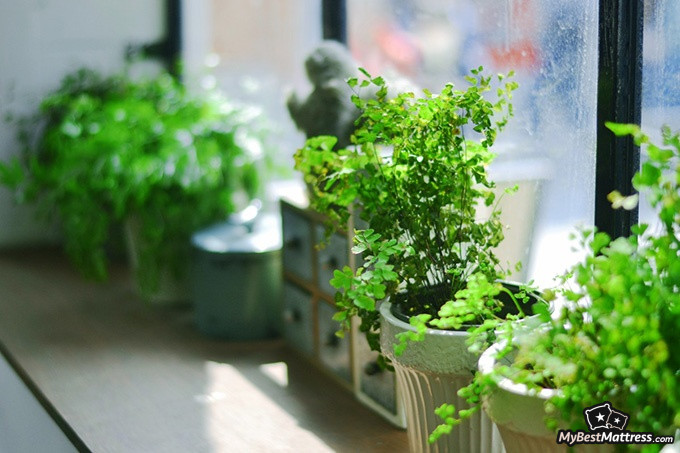
In addition, they positively affect the air in your bedroom. Fresh air before bed is one of the most frequent pieces of advice. While plants of course don’t have such direct and intense effect, they do produce oxygen. This way, especially during cold seasons, you can help add at least a little bit of fresh air in your bedroom while you sleep.
Of course, not every plant has a certain helpful effect on you. You would need to know the specific plants that induce sleep. And that’s what I'll help you with, telling about such suitable bedroom plants in more depth.
Smell the Flowers. I Mean, the Plants
Taking care of a plant can definitely soothe your soul. But what about soothing your body? Well, plants can do that too. Not every plant, of course, but there are several which do have a calming effect.
The general effect of plants on our emotions or stress is somewhat complicated to determine. However, a prominent feature of plants that we can definitely feel is their fragrance. Aromatherapy has been scientifically proven to help with anxiety or reduce stress[2]. Most importantly, aromatherapy improves the quality of sleep[3].
So let’s talk about some plants that induce sleep with their calming fragrances.
Aloe vera is largely used in the cosmetics industry for its dermatological qualities. If you’ve ever used an aloe vera product, you probably remember quite a noticeable aroma. While it can be displeasing to some, a gentle level of aroma from the actual plant is quite soothing and helpful to relax.
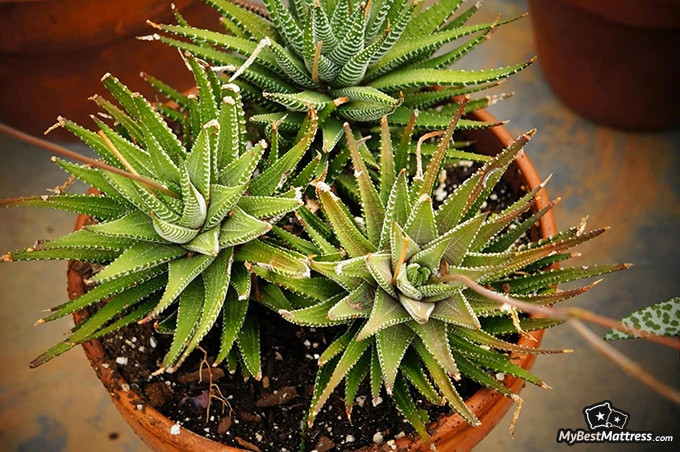
Aloe vera plants need bright, indirect sunlight or artificial lights. The ideal temperature for it is between 55-80°F — your usual room temperature should do. It needs to be watered a fair amount, but not frequently.
Lavender is one of the best-known plants to soothe and calm with its aroma. Research has shown that inhaled lavender improves sleep quality[4]. Originating in the Mediterranean region, lavender needs full sun exposure and quite dry soil. It requires only infrequent pruning, thus lavender is quite an easy plant to maintain.
Most often used for teas or medicine, chamomile can also mitigate effects of anxiety[5]. The best conditions for a chamomile plant are dry soil, partial shade, and cool temperature.
There are actually two types of chamomile — German and Roman. German chamomile produces more flowers, but Roman chamomile gives off a stronger aroma, which is what we’re after in this case.
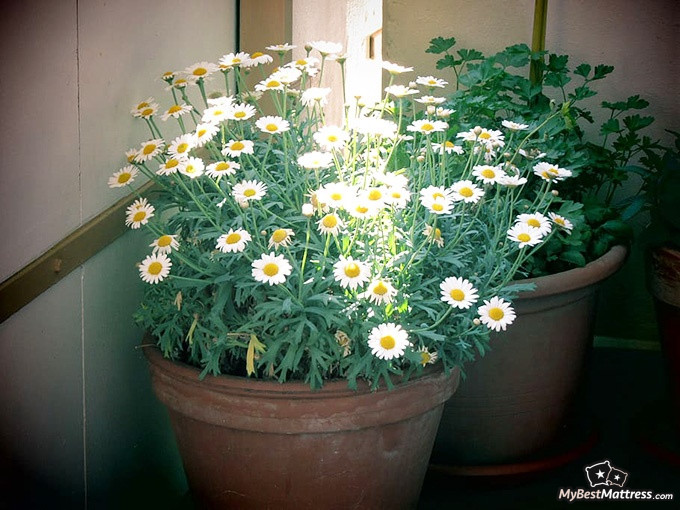
Another well-known plant for calming your nerves down is Valerian. Valerian extracts have been used in research, and it has indicated helpful effects for insomnia[6]. Usually an outdoor plant, you can grow Valerian at home in a flowerpot. It usually grows up to only 6 inches high, but up to 18 inches wide.
Lemon balm is a bit of a jack of all trades. Its extract is used in medicine or aromatherapy, you can also make tea or essential oils from this plant. It's up to 32 inches high, you only need to water it every few days, and its leaves smell like lemon with a splash of mint. Moreover, you can later use those leaves for tea or cooking!
Oxygen from Plants
In order to discuss which bedroom plants would produce the most oxygen, we should take a look at how it all works. You probably already know that plants produce oxygen. But how does that happen?
It is all due to photosynthesis. Photosynthesis is a natural biological process. During it, the plants take in sunlight, water, and nutrients from the soil. They then convert it into sugars, which provide energy for the plant itself, and oxygen — which is vital for humans.
While at school, I was always taught that plants produce oxygen. And it always sounded as if this was their main task. But actually, plants focus on producing energy and fuel for themselves, and oxygen is just an incidental side product of photosynthesis.

An important component of photosynthesis is chlorophyll. Chlorophyll is a pigment that absorbs light. It is mainly this pigment that allows the plants to make photosynthesis work. It’s also what gives plants their green color.
Therefore, the greener the plant, the more chlorophyll it has, and the more oxygen it produces. Due to that, a telling sign of which species are the best plants for bedroom, is simply the amount of green color or the size of their leaves.
Indoor Plants That Produce a Lot of Oxygen
Pothos. This plant stays green even while consistently kept in the dark. Maintenance is quite easy — you only need to water a pothos every 1-2 weeks. If you keep it in the dark, the watering needs may be even rarer.
It does not care about humidity levels, and can easily thrive within standard room temperature (though it’s recommended to not have it lower than 60°F). It does have its issues, though. Pothos plant is toxic to dogs and cats. It can also be slightly toxic to humans. Extensive contact with the plant may cause skin irritations.
Spider plant grows only up to 24 inches, so you can very conveniently keep it either on the ground or on a shelf. It can also be kept in a hanging basket, though be aware that in such case, it can grow long to descend downwards.
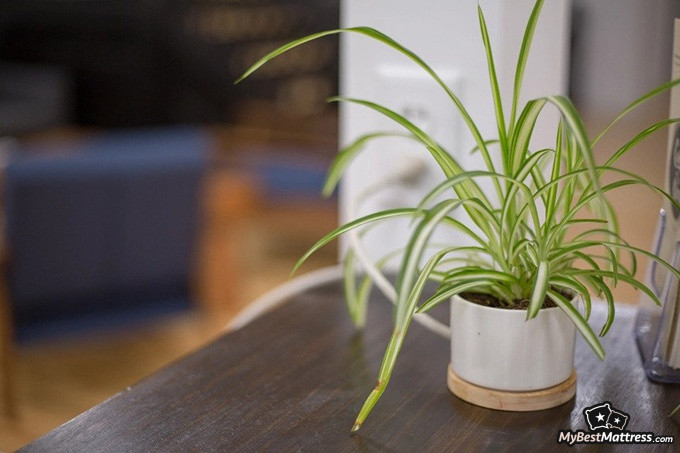
They can grow within temperatures even going down to 35°F, and are non-toxic to either humans or pets. They also produce white flowers, which will surely bring even more life into your bedroom decor.
Areca palm is a bit of a conflicted case for bedroom plants. It can grow up to 40 feet, therefore it’s more usually an outdoor plant. However, you can get smaller types for indoors. It also does. not mind being trimmed, so even if it starts growing too high for your bedroom, this palm should not give you a big headache nonetheless.
It can give a little bit of a headache in terms of its maintenance, though. It needs frequent watering and even additional fertilizer. It also needs to be repotted every couple years. However, it is non-toxic to both humans and animals, so at least there’s that worry gone.
Indoor Plants That Produce Oxygen at Night
The plants discussed in this section are also great at producing oxygen. They do go an extra step in that benefit though, as they specifically produce a generous amount of oxygen during the night. Therefore, they are very suitable to be your bedroom plants.
Snake plant is an evergreen plant, usually growing up to 3 feet height. It can do well even in low levels of light and irregular watering schedule. During winter, you will likely need to water it only once every couple of months. Now that’s what I call low maintenance!
Orchids. Yes, who could have thought that these pretty flowers can also potentially be one of the best plants for bedroom? It can grow in various circumstances, but the best conditions for an orchid are indirect sunlight and east-facing windows.
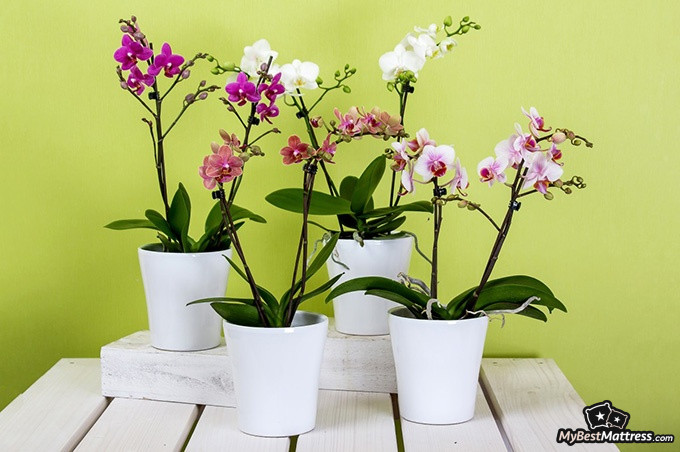
It's fine to water an orchid only once a week, but it can get a bit needier in terms of suitable temperature. The ideal temperature for this plant is 70-80°F during the day and 60-65°F during the night. They do demand fertilizing, too — once a month is fine, but the recommendation is weekly fertilization.
Christmas cactus has loads of brightly pink or red flowers. Thus it's one of the best cheerful choices for your bedroom plants. And that's in addition to producing oxygen at night. However, in order for the flower buds to form, you would need to have at least 12-hour intervals of complete darkness for several days.
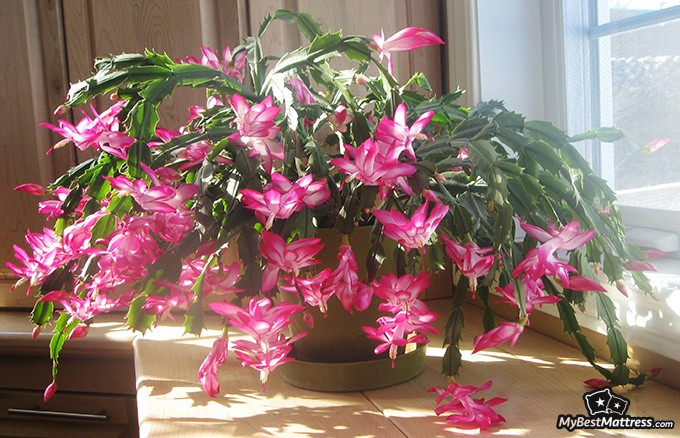
Originating from the Arabian peninsula, aloe vera is known for its benefits to your skin. However, it also releases oxygen at night, making it a great addition to your bedroom plants.
It grows up to 35 inches, so you should be able to fit it into your bedroom quite easily. It is a succulent plant though, and succulents are known for considerably more demanding care.
NASA Clean Air Study
The Nasa Clean Air Study was a scientific project, organized by… well, NASA. The research was conducted, together with the Associated Landscape Contractors of America, about how to clean air in space stations.
The research proposed that a good number of common indoor plants could be significantly helpful. These plants were believed to remove certain pollutants from the air. More specifically: benzene, formaldehyde, and trichloroethylene.
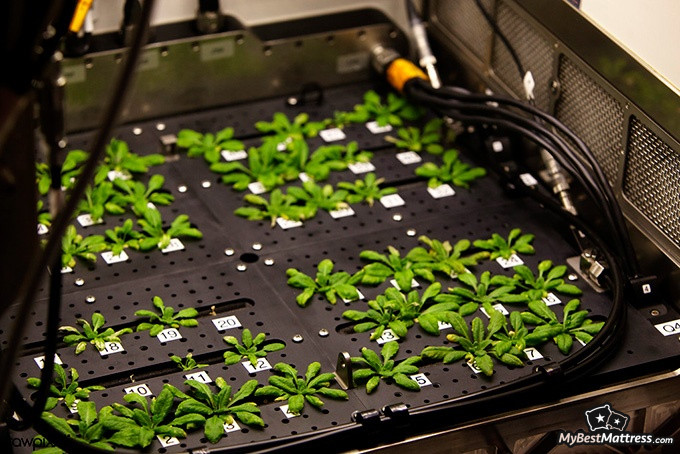
Benzene is a carcinogen (i.e. a cancer-inducing substance) and is often responsible for bone marrow failure. Formaldehyde is another carcinogen, declared a toxic substance back in 1999. Trichloroethylene damages the central nervous system if you breathe it in. Definitely useful to remove these chemicals from the air, right?
During the experiment 19 plants were tested, and 12 of them removed all three tested pollutant substances from the air. Even more so, these plants require low levels of light. Therefore they are among the best plants for bedroom, where it’s usually dim.
Air-Purifying Plants
Let’s take the Nasa Clean Air Study for basis and discuss some of the plants that help you sleep, by cleaning the air from pollutants.
English Ivy. In the wild, English ivy can grow between 60 to 100 feet. So this may be something to consider if purchasing this plant. However, this growth would not be as active during the first 2-3 years. Therefore, depending on your planned duration with English ivy, that may not be such a huge burden after all.
One thing to have in mind is that English ivy is considered an invasive species in quite a few states. You may want to check with your local regulations about potential restrictions for it. Most of such restrictions, though, would be regarding planting it outside, rather than keeping it in your bedroom.
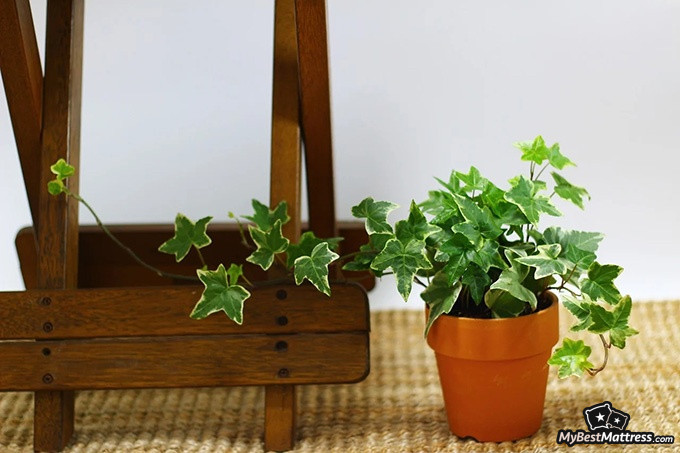
Peace lily usually grows up to 6 feet high, but if kept at home, the usual height is about 3 feet. Peace lily prefers bright light, but it can still thrive in somewhat darker environments. It does not like direct sunlight though. This sounds great for your bedroom plants, since you’d have a reasonable amount of light during the day.
This lily likes its soil moist, but not overwatered. The plant is slightly toxic to both humans and animals if ingested. So please keep it away from being nibbled by either your pets or maybe even humans.
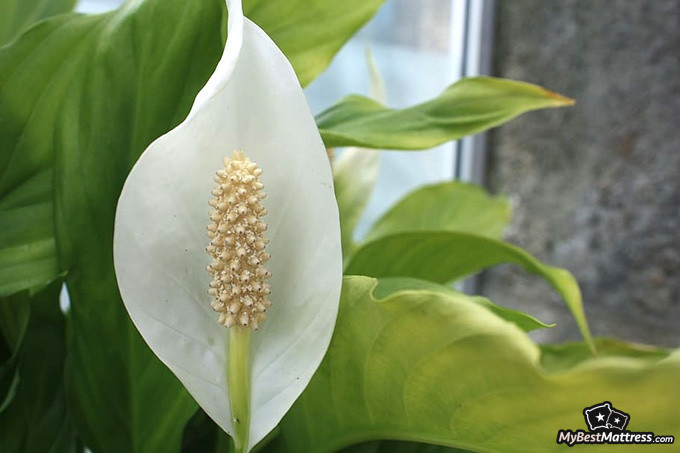
Even though bamboo palm is a tropical plant, it can thrive growing under dim light. Their adult height is between 4 and 12 feet, though they will grow taller if you keep them under more light. Caring for bamboo palm is relatively easy. Just water it with room temperature filtered water, but make sure it’s not overwatered.
Parlor palm grows between 6.7-9 feet tall, though in rare cases it can reach up to 16 feet. It does develop fragrant flowers, so you may want to consider your preferences if you’re thinking about adding this palm to your bedroom plants collection.
Being native to Southern Mexico and Guatemala, it does like tropical conditions. So make sure to provide it with warmth and it should definitely be kept indoors during the winter.
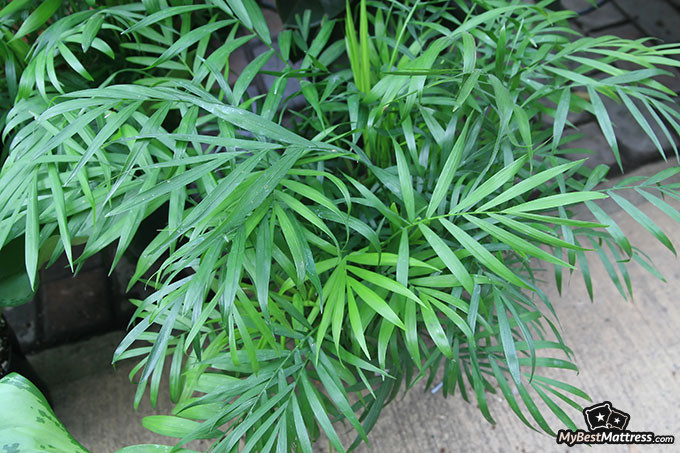
It prospers the most in moderate lighting and moderate humidity environment. However, it can grow just normally with either dryness or high humidity, and less lighting. The lighting should not be direct sunlight though, which is something in common for the majority of both house plants and bedroom plants.
Lady palm grows up to 14 feet in height, but only up to a foot per year. There are also miniature varieties of lady palm, which are much more suitable for indoor maintenance. This palm can take low lighting environments very well.
Aside from the benzene and formaldehyde, snake plant also absorbs xylene and toluene. Xylene damages the central nervous system, and toluene can cause various symptoms like fatigue, memory loss, nausea, even color vision or hearing loss. Due to this, snake plant can prevent the negative effects of some airborne allergies.
Alternative Measures to Improve Your Sleep
One thing to note about the NASA Clean Air study, however, is that this experiment was conducted under essentially lab conditions. Or at least, very different conditions than you would be likely to have at home. The experiment was also conducted over 20 years ago.
Therefore, an opposing argument was made by The Atlantic magazine in 2019. According to their calculations, in order for these plants to actually purify the air, you would need to absolutely cram the whole room with plants.
I still think (and I assume you agree) that having bedroom plants is beneficial. First and foremost, plants very often bring you joy. It adds up an element of routine that’s quite easy to maintain. They also produce oxygen, which is helpful during your sleep, no matter the level of toxins.
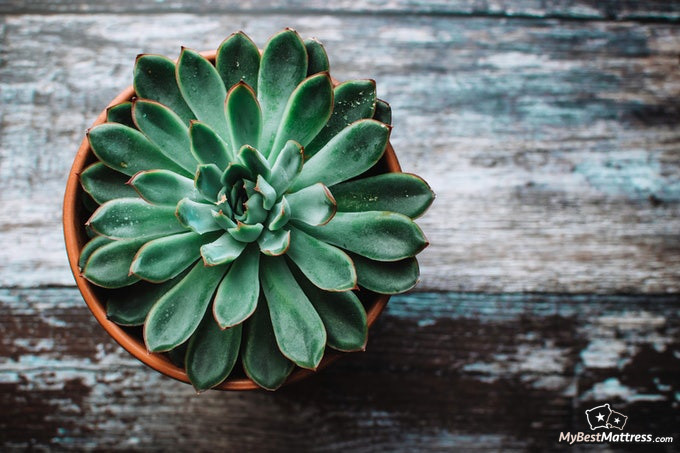
At the same time, scientific calculations should not simply be ignored. Therefore, it is useful to look for alternatives to bedroom plants that would improve the quality of your sleep. And maybe even have a more direct impact.
Make sure to have healthy sleep habits. Have at least 7 hours of sleep per night, go to bed around the same time every time, don’t use electronics or overeat right before sleep.
Invest in a suitable and comfortable mattress. The perfect mattress does not just mean good material. For example, did you know that one of the criteria for a good mattress is accommodating your sleeping position?
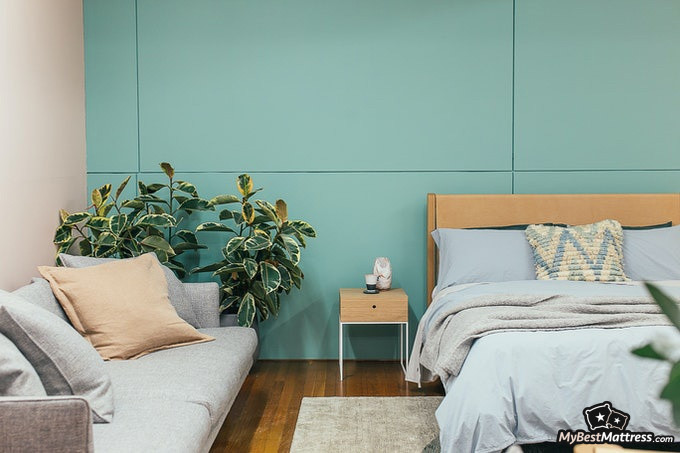
A quality mattress is the quickest and the simplest way to ensure your sleep is relaxing and comfortable. The most popular and trusted brands for mattresses at the time of writing are Saatva (rated as the best mattress of 2023 in US), Puffy (101-day trial and lifetime warranty), and Layla (affordable and flippable mattress).
Another highly important bedding item is your pillow. During sleep, your whole body should feel rested, including your head and your neck. There have been too many times where I woke up with a sore neck for the next half of a day, just because my pillow got wonky in the middle of the night.
Let in some fresh air. While bedroom plants do help with oxygen, their effect is slow and long-term. Simply having a well-ventilated room, or opening up a window shortly before sleep, has an imminent effect.
Things To Consider When Buying Bedroom Plants
You have now decided to indulge in bedroom plants and acquire one for yourself. Great! But also don’t rush just yet. There are several important factors you should consider before committing to a plant of your choice. Make sure to research your target plant before actually bringing it home.
Will it have enough sunlight in your home? And even more importantly, in your bedroom? Most plants require a good amount of bright, indirect sunlight. Certain plants require bigger amounts of sunlight than others. Some plants may even need to be specifically facing the East window or the North window.
Will it have enough space to grow? Some plants can get quite tall, while others grow into width. If your shelves are high up, consider opting out for a trailing plant. Or maybe even hang such plant down from the ceiling? Even if your flowerpot is on the ground, make sure there will be enough space for it to grow upwards.
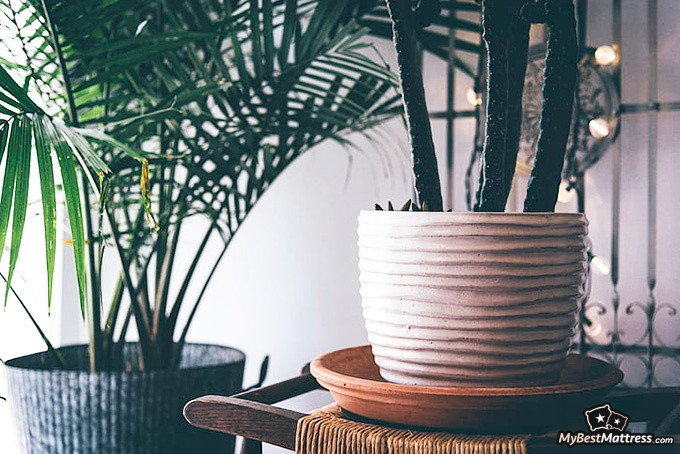
Depending on their origin country or region, certain plants require a particular amount of humidity to be present. If you have insufficient humidity for your wanted plant, you could purchase an air humidifier to help you in that regard. However, such device may not be for your preference or, in some cases, budget plans.
Of course, the temperature is also very important. The United States Department of Agriculture (USDA) has established a plant hardiness zones map. Using this map, you can see what temperatures are prominent in your area. With that, you can quickly determine if the plant can thrive in your temperature zone.
Certain plants are toxic if eaten by either pets or humans. Now, while you probably understand you shouldn’t snack (or even simply chew) on your potted plant’s leaves yourself, it’s a different story if you have small children. Some plants could also induce allergic skin reactions, so please always have that in mind before purchasing.
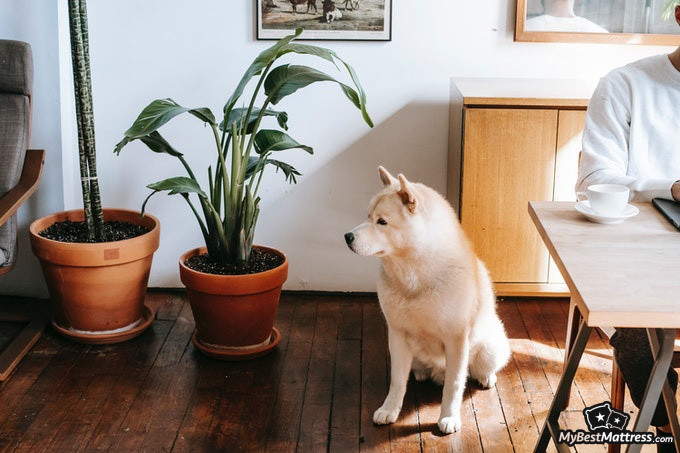
Please don’t bring an outdoor plant for keeping indoors. There are some cases where outdoor plants have indoor-friendly versions or similar species. Sometimes you can even get away with just regular trimming. But overall, please have in mind that outdoor plants are not inside-friendly.
Trimming is not the only maintenance your plant will need. In addition to watering, certain plants require regular replanting, adhering to pests, fertilizing their soil, or making sure it’s not over/underwatered. In other words, they may require diligent attention and work.
You should consider your willingness to actively keep up with the plant’s needs. Or simply your availability — if a plant needs daily attention, and you’re frequently traveling, particular bedroom plants may not be the option for you.
Conclusions
Plants are lovely companions and a great influence on your body and your soul. They’re the pretty little addition to your bedroom plants and to your life, the addition that you probably didn’t know you wanted. In addition, there is a variety of plants that induce sleep.
Plants that help you sleep do so in three main ways: the oxygen it produces, the soothing effect it has, and the potential to clean the air. Based on these criteria, some of the best plants for bedroom are aloe vera, snake plant, spider plant, and several palm species.
However, no plant can outweigh the benefits of maintaining good sleep hygiene like having a good mattress or other bedding. Before getting any of the bedroom plants, please double-check the relevant information about what conditions they need or what effects they may have.
If you help your bedroom plants flourish, they will help you to sleep better. I don’t know if you had already considered getting a plant before reading this article, but the idea of getting a new one for my bedroom has definitely grown on me.
Scientific References
1. Min-sun Lee, Juyoung Lee, Bum-Jin Park, et al.: 'Interaction with indoor plants may reduce psychological and physiological stress by suppressing autonomic nervous system activity in young adults: a randomized crossover study'
2. Pingping Guo, Ping Li, Xuehui Zhang, et al.: 'The effectiveness of aromatherapy on preoperative anxiety in adults: A systematic review and meta-analysis of randomized controlled trials'
3. Pi-Chu Lin, Pi-Hsia Lee, Shu-Ju Tseng, et al.: 'Effects of aromatherapy on sleep quality: A systematic review and meta-analysis'
4. Angela Smith Lillehei, Linda L Halcón, Kay Savik, et al.: 'Effect of Inhaled Lavender and Sleep Hygiene on Self-Reported Sleep Issues: A Randomized Controlled Trial'
5. Jun J Mao, Sharon X Xie, John R Keefe, et al.: 'Long-term chamomile (Matricaria chamomilla L.) treatment for generalized anxiety disorder: A randomized clinical trial'
6. F Donath, S Quispe, K Diefenbach, et al.: 'Critical evaluation of the effect of valerian extract on sleep structure and sleep quality'
Leave your honest feedback
Leave your genuine opinion & help thousands of people to choose the best mattress. All feedback, either positive or negative, are accepted as long as they’re honest. We do not publish biased feedback or spam. So if you want to share your experience, opinion or give advice - the scene is yours!





